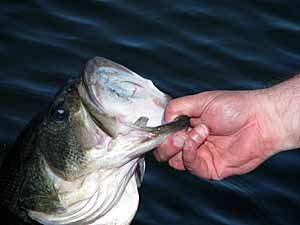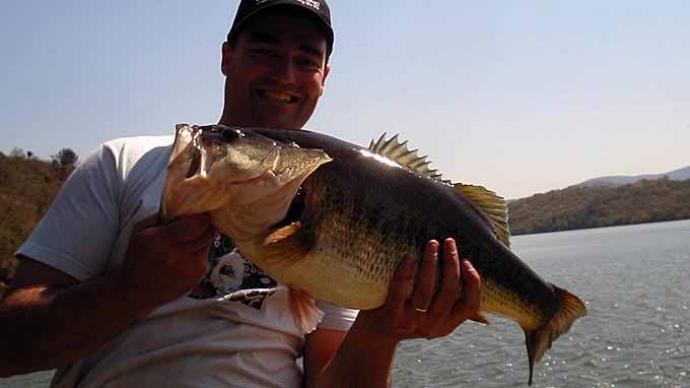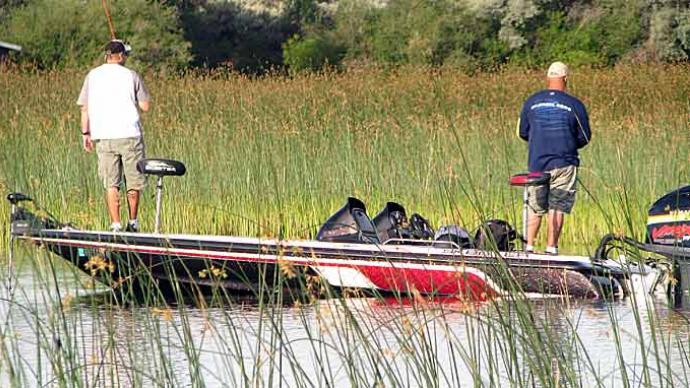
And I'm not talking about your favorite salsa or a fresh jalapeno pepper. I'm talking about bass fishing in the heat of the day on a sweltering, hot day in south Texas. There is nothing like south Texas heat. You go to bed, it's still 100 degrees or more, wake up at 5:00 a.m. and it's a chilly 85. No there's nothing quite like it. But south Texas bass are accustomed to the heat, more so than fishermen. At least they don't sunburn like us crazy fishermen.
Every year I see the same scenario. Spring comes and goes real quick. Then the heat sets in and the fishing slows way down for a while. Then about the middle of June, it starts to pick up once again. I actually catch more big bass here on Amistad during the months of June, July, and August than any other time. For years on Lake Amistad all you needed was your favorite topwater lure during the first few hours of the day. But over the past two summers at least for me, the topwater bite has really been off. The Rat-L-Trap bite has, on the other hand, been real good. My favorite time to throw a Rat-L-Trap is from first light until about noon, sometimes a little later, but usually by noon it's time to start pitching a jig into the grass or dragging a Carolina rig along a drop-off.
I try to keep my Rat-L-Trap colors to a few basic ones like chrome/blue or chrome/black, and I always use the larger models 3/4- or 1-ounce, and sometimes even the hand-sized striper model that weighs a ton (or so it seems). I throw these baits on a medium action 6-foot, 6-inch rod with a 6-to-1 Quantum reel spooled with 20-pound Green Trilene Big Game. I work these Traps extremely fast, casting up against the edge of the hydrilla and then burning them back to the boat. This will wear your arms out in a hurry, but who cares if the bass are biting? You can rest when you go home.
At first light I will be sitting on a flat with one thing in mind and that is covering water in a hurry until I connect with the first bass. Usually these bass are schooled-up pretty good by this time of year and you can catch several from one spot. If you locate a good spot and catch a few then all of a sudden the action stops, try feeding them a wacky worm. This will get the attention of lazy bass that are not willing to chase a Trap.
On Lake Amistad, and most other south Texas lakes, in the summer you can bet the wind will be blowing at first light. Sometimes it will be downright rough, but that's part of the game in this area. Sometimes the wind is a real pain and holding still is almost impossible. This is when I break out my anchor and toss it into the grass. I have sat as long as four hours in one spot and waited for the bass to come by. If you catch a few in one spot and the action dies, just wait around a little while or change baits and the action will usually pick back up. While anchored, my favorite baits are wacky worms, and Zoom Super Flukes. Just let the wind blow your line around and you might be surprised at what happens. I like to Texas rig flukes with a small weight, either 1/8- or 3/16-ounce, and actually work it like a worm, even dead-sticking it at times.
Between markers 4 and 7 on the Texas side of Amistad you will find lots of grass and constant depth changes. I try to anchor on the edge of the grass in about eight to 15 feet of water and cast into the deeper water. It's amazing how many bass will bite under the boat while you are anchored. If you're patient and willing to sit still for a while, it can really pay off early in the morning. These bass feed on the flats and run in and out of the deeper cuts in big numbers. They are accustomed to hearing trolling motors humming over their heads. I guess this is why they are not scared of an anchored boat sitting on top of them either. I have seen on many occasions that the bite is weak in the early morning hours, but around 10:00 a.m., the bass will turn on for a couple of hours. Take advantage of this small window of opportunity. I remember during many tournaments not having a single keeper in the boat, but by 10:00 having that change quickly.
Over the years on Amistad, hydrilla has taken over as the main source of cover. This is the single greatest thing that has ever happened here. We no longer have to cast at rocks and hidden pieces of cover or structure. Although there are still bass that hold on these structures, the majority have switched to the grass. If you get lucky enough to fish on a rare cloudy day, you can bet the bass will stay active around the grass most of the day. Again a Rat-L-Trap or even a fast-moving spinnerbait worked along the grass edges will produce bass. Most of my biggest bass have been caught during the hottest months, and most were caught around midday.
Hot weather also means hot jig fishing in the grass. Last year was very good to the jig chunkers. Most of the bass fishermen here were using Terry Oldham's 1-ounce jig. Green seemed to be the best color with a craw worm trailer.
Locating bass in the grass with a jig can sometimes be frustrating, everything looks the same, and everything looks fishy. But jigging the grass is like anything else, there will be certain areas that hold the bass and other places that don't. Look for edges close to deeper water. The water here is super clear and the grass grows deep, so horsing them out is the only way. Don't play around after you set the hook. I'm not an expert at jigging the grass, but I know one thing for sure, it's nice and cool under that canopy of green and that's where Mr. Bass spends his time escaping from the sun and ski boats. So get in there and go after them.
Hot weather is downright miserable for some people, but there are others that can stay out in it all day. Sometimes that is what it takes if you want to get bit. When you think about it, Texas is hot all over the state during the summer. In the east they have some pretty miserable humidity, in the west it's downright oven hot. Here in south Texas we get both. How lucky we are. Another downfall to hot weather is dropping lake levels. Across the state you can see it anywhere you look. I'm sure there are several east and north Texas lakes that caught some much-needed water over the winter and spring, but for the most part we are hurting state-wide. On both Falcon and Amistad it has been a long time since we had the luxury of choosing where to launch our boats. We basically need a flood to happen out west and bring a wall of water down the Rio Grande into Amistad. Then that can be released to go down to Falcon. I know there are a lot of fair-weather fishermen out there, myself included, who hate the heat, but if you wait for only nice weather in Texas you will spend a lot time at home. Putting up with the heat is much easier to deal with if the fish are biting. Just remember your sunscreen. Also jumping in the water and cooling off seems to help, for a few minutes anyway.
Some like it hot and some like it cold, but the bottom line is no matter the temperature I have never caught a big old bass sitting at home. Don't let the heat stop you. We have all heard about the dog days of summer and bass with lockjaw. But bass have to eat and we can learn to adjust to their needs. And there are plenty of days down here in the south where those high temperatures seem to turn them on.
You can always go night fishing, if you prefer. It's quiet, it's cooler, and the bass bite good. You have the lake almost to yourself and there are no lines at the boat ramp. There's definitely no sunburn, either. That sounds pretty good. I think it's time to replace the batteries in my flashlight.




